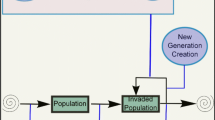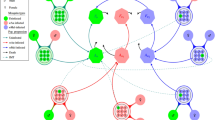Abstract
This paper uses a reaction–diffusion approach to examine the dynamics in the spread of a Wolbachia infection within a population of mosquitoes in a homogeneous environment. The formulated model builds upon an earlier model by Skalski and Gilliam (Am. Nat. 161(3):441–458, 2003), which incorporates a slow and fast dispersal mode. This generates a faster wavespeed than previous reaction–diffusion approaches, which have been found to produce wavespeeds that are unrealistically slow when compared with direct observations. In addition, the model incorporates cytoplasmic incompatibility between male and female mosquitoes, which creates a strong Allee effect in the dynamics. In previous studies, linearised wavespeeds have been found to be inaccurate when a strong Allee effect is underpinning the dynamics. We provide a means to approximate the wavespeed generated by the model and show that it is in close agreement with numerical simulations. Wavespeeds are approximated for both Aedes aegypti and Drosophila simulans mosquitoes at different temperatures. These wavespeeds indicate that as the temperature decreases within the optimal temperature range for mosquito survival, the speed of a Wolbachia invasion increases for Aedes aegypti populations and decreases for Drosophila simulans populations.







Similar content being viewed by others
References
Balasuriya, S. (2010). Invasions with density-dependent ecological parameters. J. Theor. Biol., 266(4), 657–666.
Brelsford, C., & Dobson, S. (2011). Short note: an update on the utility of wolbachia for controlling insect vectors and disease transmission. Asia-Pac. J. Mol. Biol. Biotechnol., 19, 85–92.
Coyne, J. A., & Milstead, B. (1987). Long-distance migration of Drosophila. 3. Dispersal of D. melanogaster alleles from a Maryland orchard. Am. Nat., 130(1), 70–82.
Coyne, J. A., Boussy, I. A., Prout, T., Bryant, S. H., Jones, J. S., & Moore, J. A. (1982). Long-distance migration of Drosophila. Am. Nat., 119(4), 589–595.
Farkas, J. Z., & Hinow, P. (2010). Structured and unstructured continuous models for Wolbachia infections. Bull. Math. Biol., 72(8), 2067–2088.
Fraser, D. F., Gilliam, J. F., Daley, M. J., Le, A. N., & Skalski, G. T. (2001). Explaining leptokurtic movement distributions: intrapopulation variation in boldness and exploration. Am. Nat., 158(2), 124–135.
Hancock, P. A., & Godfray, H. C. (2012). Modelling the spread of Wolbachia in spatially heterogeneous environments. J. R. Soc. Interface, 9(76), 3045–3054.
Hancock, P. A., Sinkins, S. P., & Godfray, H. C. J. (2011). Population dynamic models of the spread of Wolbachia. Am. Nat., 177(3), 323–333.
Hancock, P. A., Sinkins, S. P., & Godfray, H. C. (2011). Strategies for introducing Wolbachia to reduce transmission of mosquito-borne diseases. PLoS Negl. Trop. Dis., 5, e1024.
Hastings, A., Cuddington, K., Davies, K. F., Dugaw, C. J., Elmendorf, S., Freestone, A., Harrison, S., Holland, M., Lambrinos, J., Malvadkar, U., Melbourne, B. A., Moore, K., Taylor, C., & Thomson, D. (2005). The spatial spread of invasions: new developments in theory and evidence. Ecol. Lett., 8(1), 91–101.
Hoffmann, A. A., Montgomery, B. L., Popovici, J., Iturbe-Ormaetxe, I., Johnson, P. H., Muzzi, F., Greenfield, M., Durkan, M., Leong, Y. S., Dong, Y., Cook, H., Axford, J., Callahan, A. G., Kenny, N., Omodei, C., McGraw, E. A., Ryan, P. A., Ritchie, S. A., Turelli, M., & O’Neill, S. L. (2011). Successful establishment of Wolbachia in Aedes populations to suppress dengue transmission. Nature, 476(7361), 454–457.
Hosono, Y. (1998). The minimal speed of traveling fronts for a diffusive Lotka–Volterra competition model. Bull. Math. Biol., 60(3), 435–448.
Jones, J. S., Bryant, S. H., Lewontin, R. C., Moore, J. A., & Prout, T. (1981). Gene flow and the geographical distribution of a molecular polymorphism in Drosophila pseudoobscura. Genetics, 98(1), 157–178.
Keeling, M. J., Jiggins, F. M., & Read, J. M. (2003). The invasion and coexistence of competing Wolbachia strains. Heredity, 91(4), 382–388.
Maidana, N. A., & Yang, H. M. (2008). Describing the geographic spread of dengue disease by traveling waves. Math. Biosci., 215(1), 64–77.
Mcmeniman, C. J., Lane, R. V., Cass, B. N., Fong, A. W., Sidhu, M., Wang, Y. F., & O’Neill, S. L. (2009). Stable introduction of a life-shortening wolbachia infection into the mosquito Aedes aegypti. Science, 323(5910), 141–144.
Murray, J. D., Stanley, E. A., & Brown, D. L. (1986). On the spatial spread of rabies among foxes. Proc. R. Soc. Lond. B, Biol. Sci., 229(1255), 111–150.
Ndii, M. Z., Hickson, R. I., & Mercer, G. N. (2012). Modelling the introduction of Wolbachia into Aedes aegypti mosquitoes to reduce dengue transmission. ANZIAM J., 53, 213–227.
Price, C. S., Kim, C. H., Gronlund, C. J., & Coyne, J. A. (2001). Cryptic reproductive isolation in the Drosophila simulans species complex. Evolution, 55(1), 81–92.
Schofield, P. (2002). Spatially explicit models of Turelli–Hoffmann wolbachia invasive wave fronts. J. Theor. Biol., 215(1), 121–131.
Shigesada, N., & Kawasaki, K. (1997). Biological invasions: theory and practice. London: Oxford University Press.
Siddiqui, W. H., & Barlow, C. A. (1972). Population growth of drosophila melanogaster (diptera: Drosophilidae) at constant and alternating temperatures. Ann. Entomol. Soc. Am., 65(5), 993–1001.
Skalski, G. T., & Gilliam, J. F. (2003). A diffusion-based theory of organism dispersal in heterogeneous populations. Am. Nat., 161(3), 441–458.
Turelli, M. (1994). Evolution of incompatibility-inducing microbes and their hosts. Evolution, 48(5), 1500–1513.
Turelli, M. (2010). Cytoplasmic incompatibility in populations with overlapping generations. Evolution, 64(1), 232–241.
Turelli, M., & Hoffmann, A. A. (1991). Rapid spread of an inherited incompatibility factor in California Drosophila. Nature, 353(6343), 440–442.
Walker, T., Johnson, P. H., Moreira, L. A., Iturbe-Ormaetxe, I., Frentiu, F. D., McMeniman, C. J., Leong, Y. S., Dong, Y., Axford, J., Kriesner, P., Lloyd, A. L., Ritchie, S. A., O’Neill, S. L., & Hoffmann, A. A. (2011). The wMel Wolbachia strain blocks dengue and invades caged Aedes aegypti populations. Nature, 476(7361), 450–453.
Wang, M. H., & Kot, M. (2001). Speeds of invasion in a model with strong or weak Allee effects. Math. Biosci., 171(1), 83–97.
Wilson, D. S., Clark, A. B., Coleman, K., & Dearstyne, T. (1994). Shyness and boldness in humans and other animals. Trends Ecol. Evol., 9(11), 442–446.
Wolf, M., Van Doorn, G. S., Leimar, O., & Weissing, F. J. (2007). Life-history trade-offs favour the evolution of animal personalities. Nature, 447(7144), 581–584.
Yang, H. M., Macoris, M. L. G., Galvani, K. C., Andrighetti, M. T. M., & Wanderley, D. M. V. (2009). Assessing the effects of temperature on the population of Aedes aegypti, the vector of dengue. Epidemiol. Infect., 137, 1188–1202.
Acknowledgements
The work of MHTC was supported by the Australian Postgraduate Award. PSK was supported by the ARC Discovery Early Career Research Award.
Author information
Authors and Affiliations
Corresponding author
Rights and permissions
About this article
Cite this article
Chan, M.H.T., Kim, P.S. Modelling a Wolbachia Invasion Using a Slow–Fast Dispersal Reaction–Diffusion Approach. Bull Math Biol 75, 1501–1523 (2013). https://doi.org/10.1007/s11538-013-9857-y
Received:
Accepted:
Published:
Issue Date:
DOI: https://doi.org/10.1007/s11538-013-9857-y






